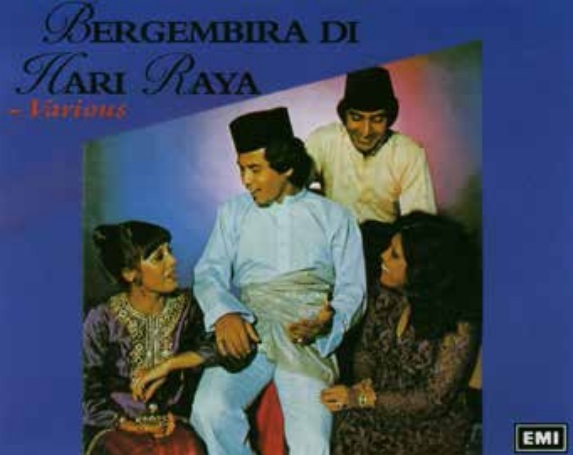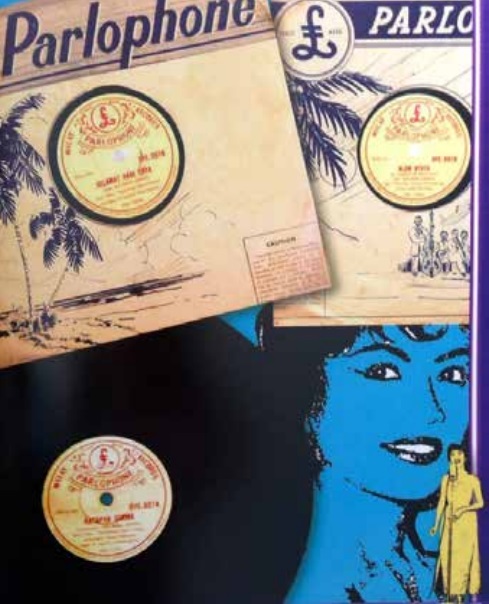
Selamat Hari Raya, the theme song composed for a 1954 Singapore-made Cathay film of the same name, composed by Ahmad Jaafar (SBC Orchestra conductor in the 1980s) and sung by Singapore artiste Nona Asiah; photo courtesy of the author
This is the third of seven articles on Hari Raya and Malay Culture appearing in the July/August 2014 issue of PASSAGE, the magazine of the Friends of the Museum (FOM).
Article by Azlan Mohamed Said.
Hari Raya Aidilfitri celebrations would feel incomplete if Hari Raya songs were not played over the radio or in the shopping malls during the fasting month of Ramadan. These songs are seasonal and they can be compared to Christmas songs that can bring sentimental tears or create a jubilant mood during that festive season. These songs became a tradition after the late 1940s when an increasing number of Hari Raya songs were played over the radio at the end of the second week of Ramadan. Many listeners requested their favourites and dedicated them to their loved ones. After the establishment of the first radio station in Malaya in 1929 the only non-commercial song that had been sung was the Takbir, an Islamic hymn sung solemnly in Arabic during the eve of Hari Raya and still heard over the radio today.
According to the author of Muzik Melayu Dari Tahun 1940an [Malay Music from the 1940s], Mr Yusnor Ef, who wrote several classic Hari Raya song lyrics and was also a musicologist, the first Hari Raya song was recorded in the late 1940s and was sung by Syed Al Idros. Simultaneously, Zubir Said, the composer of Singapore’s national anthem, wrote a song called Aidil Fitri, a duet sung by Nona Asiah and Kamsani Saat. Nona Asiah, whose pedigree hails from Malay opera (bangsawan) had just recorded the Malay cover version of Besame Mucho and had become hugely popular. The Aidil Fitri with its moving lyrics, was re-recorded in 1973 with an updated musical arrangement and was sung by Sanisah Huri. In 1949, another duet called Kain Songket, composed by M Sidin, was recorded and sung by Rokiah Wanda accompanied by the violin maestro Hamzah Dolmat. It was considered a Hari Raya song since the song’s lyrics described the Malay brocade fabric known as kain songket worn during the Hari Raya festive season.
In 1954, Cathay Film Productions produced a film called Selamat Hari Raya and Ahmad Jaafar (the music conductor for the Singapore Broadcasting Corporation Orchestra in the 1980s) was asked to compose the theme song for that film. Also named Selamat Hari Raya, the song was originally sung by Nona Asiah, who was by then the most sought-after playback singer. Then in 1955, a recording company HMV requested that it be put onto a vinyl record with the hugely popular singer Saloma making the recording. Known for her colourful expression, Saloma was the gold standard in vocal ‘lemak-ness’ , a characteristic thought to be the ideal in Malay singing, marked by a beautiful, warm tone, mellifluous and gracefully flexible. The song was composed in the Branyo beat, a Latin beat that was very popular in the 1950s and during the festive month that same year, immediately gained popularity. Following that success, several more Hari Raya songs were composed. Among them, from the mid to the late 1950s, were Suara Takbir (The Voice of the Hymn), Dendang Perantau (A Wanderer’s Song) and Manusia Miskin Kaya (People Poor and Rich). These songs were all written and sung by the legendary P Ramlee, the Malay world’s icon for music and film – he was both Sinatra and Olivier.
Indonesia, whose culture, traditions and religion are similar to Malaya and Singapore, also has songs to celebrate the festive season of Hari Raya. The Indonesians named their post-fasting month celebration Hari Lebaran. Among the earliest Hari Raya songs that were recorded in Indonesia were Hari Lebaran and Selamat Hari Lebaran, all well received by listeners in Malaya and Singapore. Indonesia’s nationally acclaimed music giant Ismail Marzuki composed Hari Lebaran in 1954 with lyrics that made fun of the Hari Raya celebrations – it was sung by a performer called Didie. Selamat Hari Lebaran was composed by M Jusuf, the bandleader of Orkes Wijaya Kusuma and sung by Oslan Hussein who became a household name in Malaya and Singapore in the early 1960s through popularising original compositions with Latin melodies and beats.
In 1964, Kassim Masdor, who was P Ramlee’s student and assistant, wrote Selamat Hari Raya, an upbeat, modern Hari Raya song sung by Fazedah Joned, a young lass from Kuala Lumpur who won the Radio Malaya Star Talentime in 1962. The popularity of the ‘Pop Yeah Yeah’ music genre, influenced by the Beatles, reached its height in the late 1960s. As a result of these developments, P Ramlee decided to re-record Dendang Perantau with the musical arrangement adapted to the style of ‘Pop Yeah Yeah’. In 1969, he wrote another version of Selamat Hari Raya with an upbeat tempo and this was sung by Ahmad Jais with lyrics written by well-known film director, Jamil Sulong. This was the last Hari Raya song P Ramlee wrote. He died of a heart attack in 1973.
In 1972, Kassim Masdor wrote his second Hari Raya song and called it Bila Takbir Bergema (When the Hymn Echoes), sung by the lovely voice of Rafeah Buang who wrote her own lyrics. A year later, Kassim wrote two more songs in a compilation album of Hari Raya songs produced by EMI Singapore with Kassim himself as the producer. Among the old Hari Raya songs re-recorded in that album were Aidilfitri sung by Sanisah Huri, Manusia Miskin Kaya sung by Eddy Nor Ali and Selamat Hari Raya sung by Saloma with some of the lyrics altered. In the original song, the words ‘Dam Dam Dum bunyi mercun’ (which mean Dam Dam Dum the sound of fireworks) were taken out because the Singapore government had banned the use of fireworks from 1 August 1972.
In 1977, another compilation album was produced and many new Hari Raya songs were added; today they are regarded as standards. The ‘icing on the cake’ is Suasana Hari Raya (Hari Raya Atmosphere), a happy and catchy tune sung by Sharifah Aini, Malaysia’s Queen of Songs.
Although many Hari Raya songs were composed in the 1980s, with some being really good, and some popular oldies were updated and re-recorded, they never quite became the classics that the original Hari Raya tunes from the 1950s to the 1970s had been. It is the ‘oldies but goodies’ Hari Raya Aidilfitri classic tunes that are perennially enjoyable. They keep coming back every year and listeners feel their spirit all over again.
Here are some Hari Raya classics that you can listen to on YouTube:
Aidil Fitri – Nona Asiah and Kamsanit Saat, late 1940s
Kain Songket – Rokiah Wanda and Hamzah D – 1949
Hari Lebaran – Didi (Composer, Ismail Marzuki) – 1954
Selamat Hari Raya – Saloma 1955
Dengdang Perantau – P Ramlee 1950s
Azlan Mohamed Said is the author of MUSIKA: Malaya’s Early Music Scene (1900-1965).





Leave a Reply